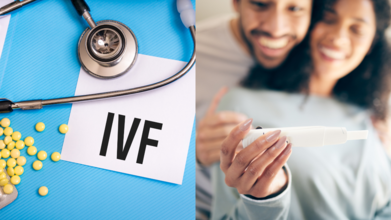- Health Conditions A-Z
- Health & Wellness
- Nutrition
- Fitness
- Health News
- Ayurveda
- Videos
- Medicine A-Z
- Parenting
- Web Stories
What Is The Difference Between HIV And AIDS?

Credits: Canva
With the US pausing its funds in the healthcare sector, along with UNAIDS, a global threat for HIV cases has risen. It has led to panic, fear, and confusion in many African countries who are the hardest hit by AIDs. In fact, official data states that this move could lead to a 6 times jump in HIV cases. While HIV and AIDS are being discussed all over the news now, not many know the difference between the two.
What is HIV? What is AIDS?
Human immunodeficiency virus or HIV is a diseases that weakens a person's immune system by attacking CD4 cells which help the body fight off infection.
Whereas AIDS, which stands for acquired immunodeficiency syndrome happens when the HIV advances.
How Is It Spread?
HIV is primarily spread by:
- Having multiple sex partners or the presence of other sexually transmitted diseases which can increase the risk of infection during sex. Unprotected oral sex can also increase for HIV, though it is a much lower risk than anal or vaginal sex
- Sharing needles, syringes, rinse water
- Being born to an infected mother
The Origin
The first known case of HIV-1 infection in human was detected in 1959, from a blood sample of a man in Kinshasa, Democratic Republic of Congo. However, the source of his infection is not known. The genetic analysis of the blood sample revealed that HIV-1 may have stemmed from a single virus in late 1940s or early 1950s.
In the US, this virus existed from mid 1970s. Between 1979-81 rare types of pneumonia, cancer and other illnesses were reported to doctors in Los Angeles and New York, and a number of the patients were men who had sex with other men. The conditions reported in those patients were not found in a person with healthy immune system. In 1982, healthcare officials began to use the term acquired immunodeficiency syndrome, that is how it was named AIDS. The DC Health website mentions that this term was used to describe the occurrences of opportunistic infections. It was in 1983 that the scientists finally discovered the virus that caused AIDS. The virus was first named HTLV-III/LAV (human T-cell lymphotropic virus-type III/lymphadenopathy-associated virus) by an international scientific committee. This name was later changed to HIV (human immunodeficiency virus).
Countries With Highest HIV Rates
As per the World Population Review, the top 10 countries with the highest HIV rates as of 2023 are:
- Eswatini at 27.5%
- Lesotho at 20.5%
- Botswania at 19.7%
- South Africa at 16.6%
- Mozambique at 11.8%
- Zimbabwe at 11.7%
- Namibia at 11.5%
- Zambia 11%
- Malawi at 7.5%
- Uganda at 5.6%
Then there are the countries with the most number of people living with HIV as per 2023:
- South Africa: 7,700,000
- India: 2,500,000
- Mozambique: 2,400,000
- Nigeria: 2,000,000
- Tanzania: 1,700,000
- Uganda: 1,500,000
- Kenya: 1,400,000
- Zimbabwe: 1,300,000
- Zambia: 1,300,000
- Brazil: 1,000,000
Three Stages of HIV
HIV progresses and becomes AIDS in three stages:
Acute HIV infection: It has flu-like symptoms in the host and starts to destroy body's CD4 T lymphocyte cells.
Chronic HIV: While the HIV levels are lower, it is still persistent. Infected individuals may have no symptoms and the risk of transmission to others is also diminished to a certain level. The World Population Review mentions: Patients on treatment plans may have virus levels so low as to be undetectable, making the risk of transmission nearly zero, and live at this stage for decades.
Acquired Immunodeficiency Syndrome: This is the third stage of HIV infection, if left untreated, it can progress to AIDS, where your body is no longer to fight off any infections.
Loving Perfection and Cleanliness Does Not Mean You Have OCD: Here Is What The Disorder Actually Means

If you have ever colour-coded your wardrobe, wiped the kitchen slabs repeatedly just because a speck of dust exists, or straightened a slightly off-centre painting on the wall, someone has probably laughed and said, I am so OCD too. But the thing is that you are probably not. And neither are they.
Somewhere along the way, we all misunderstood Obsessive Compulsive Disorder (OCD), a serious mental health condition, and casually said it. OCD has become shorthand for being neat, organised, or a lover of clean aesthetics. But as mental health professionals and those who actually live with OCD will tell you, that stereotype could not be further from the truth.
OCD is a clinically diagnosed anxiety disorder. It is not just about being extra clean or a control freak. It involves a cycle of obsessions, which are intrusive, unwanted thoughts and compulsions, which are repetitive behaviours or mental acts done to try to neutralise those thoughts.
Imagine being haunted by a constant fear that your loved one will die unless you tap the light switch exactly five times. Or being plagued by the thought that you have hit someone with your car, even though there is no evidence of it happening, and then going back to the same stretch of road again and again to check. That is the lived reality of OCD. It is not cute, it is not fun, and it definitely does not feel satisfying or neat.
The Cleanliness Myth
Yes, some people with OCD have cleanliness-related compulsions. But not everyone with OCD is a neat freak, and not all neat freaks have OCD. The need to wash your hands repeatedly until they are raw is not about loving cleanliness; it is about desperately trying to get rid of a feeling that something is terribly wrong. Often, the compulsion is not even rationally linked to the obsession. It is about trying to regain control over overwhelming anxiety, even if only temporarily.
In fact, OCD themes can be disturbingly varied, from fears of harming others to taboo thoughts to symmetry to morality. The common thing is that the thoughts are distressing, the anxiety is debilitating, and the rituals are exhausting.
Why It is Harmful To Mislabel Yourself As “OCD”
Calling yourself “OCD” because you like your stuff arranged by colour might seem harmless. But this kind of throwaway comment does a real disservice to people living with the actual condition. It trivialises their experiences and contributes to misinformation.
It also prevents those who might truly be struggling with OCD from recognising their symptoms and seeking help. Because if society keeps painting OCD as a personality problem, why would anyone think it is a serious problem?
What OCD Actually Feels Like
Ask anyone with OCD, and they will tell you it is not fun. It is not satisfying to double-check the lock for the 17th time. It is not enjoyable to feel like you are going to vomit because of a thought you did not ask for and cannot get rid of. It is a relentless loop of “what ifs” and “just in cases” that can take over your entire life.
OCD can interfere with relationships, work, sleep, and basic daily functioning. It is often accompanied by shame and secrecy because people worry others would not understand, or worse, will think they are dangerous or irrational.
Time To Rethink The Label
You might just be tidy. Or meticulous. Or even perfectionistic. And that is fine. But OCD? That is a diagnosis. A tough, often debilitating one that deserves respect. If you think you might actually have OCD, then help is available. Cognitive Behavioural Therapy (CBT), particularly Exposure and Response Prevention (ERP), has been proven to be effective. But it starts with understanding what OCD really is.
World IVF Day: What Makes The IVF Journey So Hard On The Mind?

In vitro fertilisation (IVF) is not just about science, syringes and success rates. What lies behind the walls of fertility clinics is a deeply personal journey filled with hope, heartbreak and resilience, making it more than just a medical procedure. Beyond the social taboos, infertility brings huge stress to the patients. And while IVF offers hope, it does not come easy. It is a rollercoaster ride that patients experience as they take on the road to this procedure; highs and lows can take a severe mental toll on them.
However, for those unversed, infertility has been classified by the World Health Organisation as a disease like diabetes or hypertension; the social taboo around it still persists. Over the years, advancements in reproductive science have made IVF treatments more patient-friendly and significantly improved outcomes. Yet, the focus often leans heavily on science, expertise and clinic proficiency, while the mental and emotional toll on the couple is overlooked.
For many, the psychological impact of IVF can match that of the death of a family member or going through a divorce. Although many people find IVF very stressful, every patient experiences it differently. Personalities and life experiences play a big role in determining how one handles the process and what part of IVF they find most difficult.
Why Is IVF So Emotionally Draining?
We ask an expert to break down several key factors that contribute to the immense stress IVF brings:
- Uncertainty of Outcomes
- Physical Strain
- Societal Pressure
- Guilt and Shame
- Depression After Failed Attempts
- Relationship Strain
Learning to Cope with Support Systems That Help
There is light at the end of the tunnel, and as Dr Saple says, there are several strategies that can help couples better cope with the IVF process.
- Psychological Counselling
- Support Groups
- Mind–Body Practices
Setting Realistic Expectations
“IVF may take more than one cycle to succeed,” she explains. Being mentally prepared for the outcome, while knowing you have done your best, helps couples accept results with resilience.
It is Okay to Ask for Help
As Dr Saple reminds us, mental and emotional health are as important as physical health during IVF. Prioritising emotional wellbeing not only makes the journey more bearable but can also improve the overall outcome. “Seeking help is a sign of strength, not weakness,” she says.
Family Urges Flu Vaccination After 8-Year-Old's Near-Fatal Influenza B Fight

Credits: Canva
Millie Campbell was just eight years old in 2019 when a missed flu shot turned into a life-threatening ordeal, notes ABC News, Australia. What began with aches in her legs soon escalated into multiple organ failure caused by influenza B, a virus her parents never imagined could be so severe.
“They had to drain 200 millilitres of fluid from her heart, it was struggling,” her mother Stephanie Campbell recalled. “I think the doctor's words were: ‘Your daughter could die tonight’.”
Millie was airlifted from Newcastle to Westmead Children’s Hospital in Sydney, reports ABC News. Soon after arriving, she went into cardiac arrest. Her father, Ian Campbell, described the scene as surreal. “There was no indication she was going to survive,” he said.
A Long Road to Recovery
Millie, previously fit and healthy with no pre-existing conditions, spent weeks in intensive care and six months in hospital. The damage from being on life support for so long led to poor circulation, and eventually, doctors had to amputate her left foot.
She had to learn to walk again. Today, reports ABC News, Millie uses a prosthetic leg and has turned to swimming not just for rehabilitation, but as a passion, one that has taken her to national championships and World Trials. Her eyes are now set on the 2028 Paralympics in Los Angeles.
“Millie’s recovery will be a lifelong journey,” Ms Campbell said. “Seeing how severe the flu can be, our message is: talk to your medical practitioner about the vaccine.”
Why Influenza B Is Hitting Children Hard
Although influenza A typically gets more public attention due to its pandemic potential, Australia has seen a sharp rise in influenza B cases, especially in children aged 5 to 16. According to Professor Patrick Reading from the World Health Organization (WHO) Collaborating Centre for Influenza Research, type B can often be more severe in children, though the reason remains unclear.
“It's a bit of a mystery,” Professor Reading told ABC News. “We see this association, but we can't say there's something specific about the virus that causes it to affect children more.”
Vaccination rates among this age group are currently the lowest of all, following a steady decline since the COVID-19 pandemic. Professor Reading warned that fading immunity, combined with lower vaccine uptake, is placing a burden on the healthcare system.
“We're not through the worst of it yet. Flu circulation continues through August to October,” he added. “It’s not too late to get vaccinated.”
Confusion Around Flu Vaccine Access
Millie’s parents said they’d always kept up with her vaccinations. But once she turned five, they mistakenly believed the flu wasn’t a major risk anymore.
Under the National Immunisation Program (NIP), the flu vaccine is free only for children aged six months to five years, people over 65, and other vulnerable groups.
In contrast, states like Queensland and Western Australia are temporarily offering free vaccines to all residents, a move public health experts say should be adopted nationally.
Julie Leask, a vaccination policy expert from the University of Sydney, told ABC News, the current risk-based model isn't working. “When a vaccine is on the NIP, it sends a strong message that it's important,” she said. “Some doctors still wrongly advise against it for kids.”
Misinformation and Vaccine Hesitancy
Falling childhood vaccination rates, rising anti-vaccine sentiment, and misinformation, especially on social media, have complicated public health efforts.
Professor Leask pointed to anti-vaccine rhetoric, such as that from US politician Robert F. Kennedy Jr., as a growing influence in Australia. Kennedy has falsely linked vaccines to autism and recently pushed against COVID-19 vaccinations for children and pregnant women.
“We’re seeing the mainstreaming of misinformation,” Leask warned. “It’s having a ripple effect here too.”
Research shows common reasons parents skip the flu shot for kids include a lack of awareness, absence of a healthcare provider recommendation, time constraints, cost, and safety concerns.
A Family’s Call to Action
As Millie thrives in her new life, her parents remain vocal about the importance of vaccination.
“This growing hesitancy is driven by people struggling to tell the difference between facts and misinformation,” Mr Campbell said. “Most people spend more time on social media than listening to experts, but that’s not where you should be getting your health advice.”
“Vaccination protects not just your child but the whole community.”
© 2024 Bennett, Coleman & Company Limited

